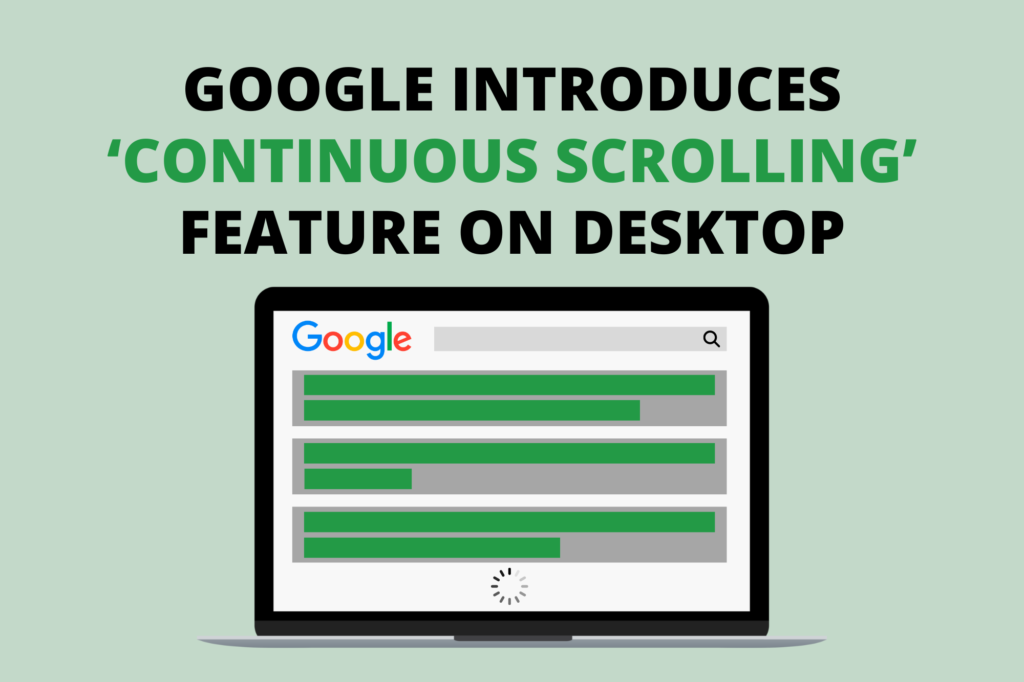I still can’t decide whether I like Google’s “Continuous Scrolling” feature that groups the first 6 pages in one continuous scroll rather than having to click on the page number at the bottom after a certain number of results.
When search engines first appeared we would often click through as many as 10 pages before giving up and probably going back to page one and clicking on the first organic result.
Gradually, over the years and before the continuous scroll we’d generally stop at the end of the first page before making a choice.
Stay tuned as we dive deeper into the world of continuous scrolling. We’ll unravel its workings, uncover Google’s motivations behind this move, and explore its potential impact on small online businesses like yours.
What’s Continuous Scrolling?
Social media platforms like TikTok and Instagram have pioneered the use of continuous scrolling, a user-friendly format allowing viewers to effortlessly explore more content.
Until recently, Google mobile search results were confined to page-by-page navigation, requiring users to click blue page numbers for deeper exploration. However, data revealed that most users stopped at the fourth page, with engagement plummeting significantly beyond that point.
A 2020 Google study confirmed this, showing click-through rates (CTR) below 1% for second-page results and a stark drop from 46.9% on the first page to 1.5% on the tenth.
Google’s new continuous scrolling feature addresses this issue by automatically loading the next page of results once a user reaches the bottom of the current page. Additionally, the “See More” button appears further down the scroll, facilitating deeper exploration before requiring interaction.
This, as Google states, enables users to “seamlessly browse through many different results,” enhancing their mobile search experience.
Here’s Why Google Is Changing Search Results
Google’s vision for continuous scrolling is simple yet impactful: to make browsing search results seamless and intuitive, especially for users with broad and open-ended questions.
Whether conducting in-depth research, exploring restaurant options, or seeking creative inspiration, continuous scrolling empowers users to consider numerous results before reaching a decision.
This intuitive format aligns with user expectations shaped by popular social media platforms, fostering a familiar and accessible search experience.
While the rollout is gradual, with initial availability for most English searches on mobile devices in the U.S., this innovative feature promises to revolutionize the way we navigate information on the go.
Here are some reasons I believe Google has released this feature:
- Consistency: They’ve previously launched continuous scroll on mobile SERPs so this change helps the results be consistent across devices
- Application UI: As the prominence of platforms such as TikTok and Instagram continues to rise, users are getting increasing expectations of infinite scroll experiences. This change matches what users experience in competing social platforms.
- Increased ad frequency: My guess is that significant testing was done and this experience will allow Google to serve more ads to users. Perhaps removing the barrier of needing a click-input in pagination accomplishes this.
- Query type: It will be interesting to see which types of queries Google released this on. They used an example of “design ideas for bedroom” which is a more informational and visual SERP. I wonder if they’ll start releasing this feature on queries with lower CTR that are conducive to “deep SERP” behavior.
The Benefits to Small Online Businesses
I think this is a pretty big deal. For the history of SEO, we’ve made jokes about page 2 being the best place to hide things because no one clicks there. This Google update changes that – now all users have to do is keep scrolling on their phones (which we’re all professionals at, at this point, am I right? ) to get continuous results.
I imagine click-through-rate (CTR) will increase quite a bit to position 10+, which is definitely worth celebrating because there’s a lot of great content that doesn’t always make it to the first page!
At GREAT Guest Posts, we believe the addition of continuous scrolling on mobile devices presents a significant opportunity for small online businesses. While our clients strive for coveted first-page rankings through SEO, the impact of continuous scrolling shifts the landscape.
Previously, first-page placement held the key to capturing user attention. Now, seamless scrolling opens a gateway to the second, third, and even fourth pages, potentially boosting clicks and traffic for content residing there.
This doesn’t diminish the value of first-page positioning, but it presents an exciting new avenue for reaching and engaging potential customers on other pages.
What Should You Do Next?
With continuous scrolling altering the search landscape, you might be wondering what adjustments your business should make. Our advice is simple: monitor your analytics closely. Pay particular attention to how your content performs on pages two to four of search results.
Once you have a clear picture of user engagement beyond the first page, you can strategically shift resources to other content that might have previously been overlooked.
This could involve highlighting underutilized content, optimizing existing pieces, or even creating new content specifically tailored to capture user interest on deeper pages. Remember, continuous scrolling doesn’t diminish the importance of first-page ranking, but it opens a valuable new avenue for reaching potential customers.
Need help crafting killer content or re-evaluating your SEO strategy? Book a free consultation call with one of our experts to unlock the full potential of continuous scrolling and propel your business forward.
Final Thoughts
As someone who values data-driven decision-making, I like to rely on A/B tests to guide my choices. However, the go-to reference for this topic seems to be an A/B test conducted by Etsy over a decade ago, which declared pagination as the winner. But here’s the thing: times have changed.
With the significant increase in mobile traffic to ecommerce sites and the widespread adoption of infinite scroll across the web, I can’t help but wonder if the tides have shifted. Has anyone conducted a substantial A/B test comparing infinite scroll and pagination in recent times? My instincts suggest that given the current landscape, infinite scroll might just be the optimal choice.



